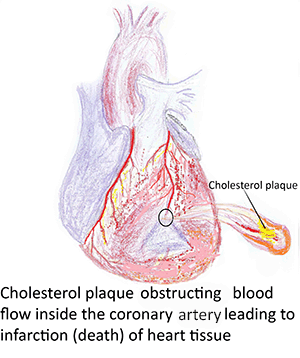High Cholesterol Levels and Impact on Health
Cholesterol is a lipid-soluble, sterol compound occurring naturally inside the human body. In addition to the dietary cholesterol, it is also synthesized inside the human body and is one of the essential components of cell membranes.
 |
Natural functions of Cholesterol
Cholesterol is an essential structural component of cell membranes and functions to maintain the stability of cells.
It is required by the human body to synthesize vitamin-D.
It is one of the chief components of bile acids and is required for the synthesis of cholic acid and chenodeoxycholic acid in the liver.
Cholesterol is the main compound from which steroid hormones, e.g. Testosterone, are produced.
High cholesterol
High cholesterol or hypercholesterolemia is a condition in which serum cholesterol levels are elevated more than 200 mg per 100 ml (dL). A reading between 200 and 239 mg/dL is labeled borderline high and a reading of 240 mg/dL and above is considered high.
Causes of elevated blood cholesterol conditions:
Familial hypercholesterolemia is a genetic condition
Diabetes Mellitus
Long standing Liver disease
Low thyroid hormone levels (Hypothyroidism)
Excess alcohol intake
Stress
Medications like Thiazide diuretics, progestogens, etc.
How cholesterol is distributed in the human body
Cholesterol and triglycerides circulate as lipoproteins in the blood. The protein component of lipoproteins is called apolipoproteins.
The main carriers of cholesterol and lipids among these lipoproteins are-
LDL (Low-density lipoprotein carries 40-50% of cholesterol),
IDL (Intermediate density lipoprotein- carries 20-40% of cholesterol),
Very low-density lipoprotein (VLDL- carries 5-15% of cholesterol 5-15%), and
Chylomicrons (carries 2-7% of cholesterol).
How high cholesterol affects health
Research studies suggest that high cholesterol levels in the blood have been found associated with coronary artery disease, stroke, and peripheral vascular disease. It is also found that adult cardiovascular disease may have its roots in childhood and adolescence.
Normally about 35-50 g of cholesterol is present inside an average-sized adult at any given time. LDL carries nearly 50% of cholesterol. Low-density and very-low-density lipoproteins (LDL and VLDL) are synthesized in the liver. It is LDL lipoprotein that elicits injury in the coronary blood vessels and leads to atheroma plaque formation. Atheromatous plaques block the smooth flow of blood in coronary vessels, which leads to heart attacks. Hence, LDL cholesterol is also called bad cholesterol.
High-density lipoprotein (HDL) is synthesized by the liver and small intestine. HDL contains phospholipids and proteins (Apo-A), which accept cholesterol and esterify it. HDL facilitates the reverse transport of cholesterol from peripheral tissues to the liver and helps in its excretion through bile. Normal HDL levels aim to reduce blood cholesterol levels. Hence, HDL is labeled as good cholesterol.
Screening for high cholesterol levels
Serum lipids should be estimated after 8 hours of standard fast as food intake leads to large variation.
Screening for hyperlipidemias should be undertaken in all high-risk cases. If the serum cholesterol level is less than 170 mg/dL, no treatment is required except revaluation at frequent intervals. If the serum cholesterol level is between 170-200 mg%, do a lipid profile test. If it is more than 200 mg%, the lipid profile followed by treatment by drugs should be considered.
However, serum LDL-cholesterol should be aimed below 130 mg%. In high-risk cases such as diabetes, or a family history of cardiac disease, LDL should be aimed below 100 mg%.
Dietary management:
The golden rule is that for better compliance, all the family members should switch over to the low-fat diet.
Step-I diet: When LDL cholesterol is more than 130 mg%, give Step-I diet 30% of total calories from fat with an equal proportion of saturated to monounsaturated to polyunsaturated fat. Restrict cholesterol to 300 mg/day. However, for high-risk patients such as diabetes, family history of cardiac disease, etc, treatment should be initiated even if the LDL cholesterol is more than 100 mg% and put on a step II diet.
Step II diet: When the LDL cholesterol is more than 130 mg%, give the Step II diet with only less than 7% of calories from fat. Restrict cholesterol to less than 200 mg/day.
Encourage fruits, vegetables, fish oils, etc. Mushrooms are fat-free food items with sufficient minerals and vitamins Skimmed milk powder can be used instead of ordinary milk.
Ensure a high-fiber diet that has cholesterol-lowering properties. Avoid hydrogenated vegetable oils which contain trans fatty acids.
Avoid butter, oil, cheese, milk cream, refined sugar, bakery items. Avoid eating in between meals.
Antioxidants like vitamin C, Beta carotene, and vitamin E have a protective role against heart disease.
Green tea is a good source of antioxidants.
In addition to the diet,
Maintain an ideal body mass index of 18.5 to 24.9.
Avoid alcohol intake
Stop cigarette smoking
Physical exercise
Live a stress-free, healthy lifestyle.
Also read ≻≻-
≻≻-Trans fats.
≻≻-list of recommended fats and oils.
≻≻-Back to Nutrition articles from High cholesterol article
Further reading and References: